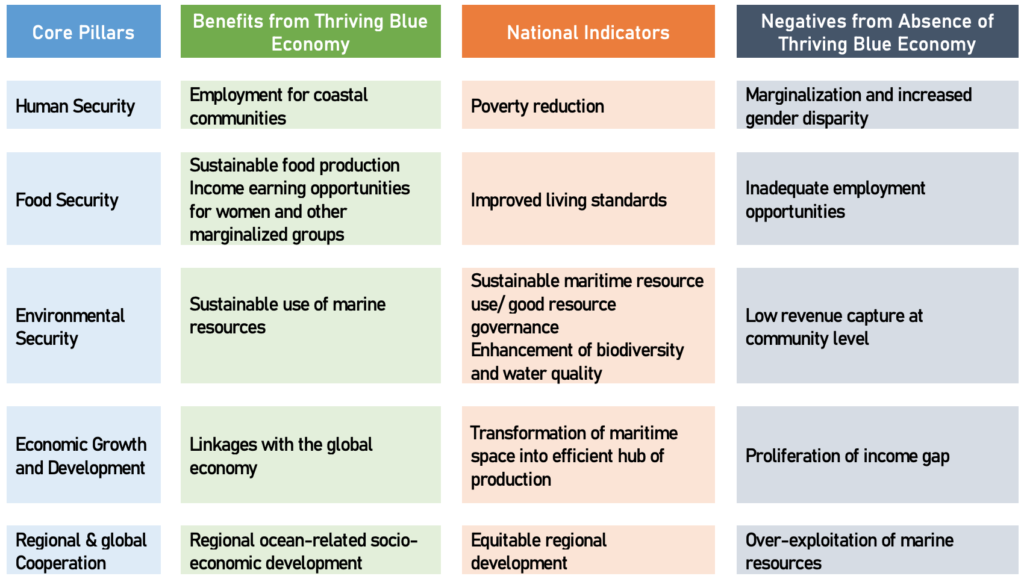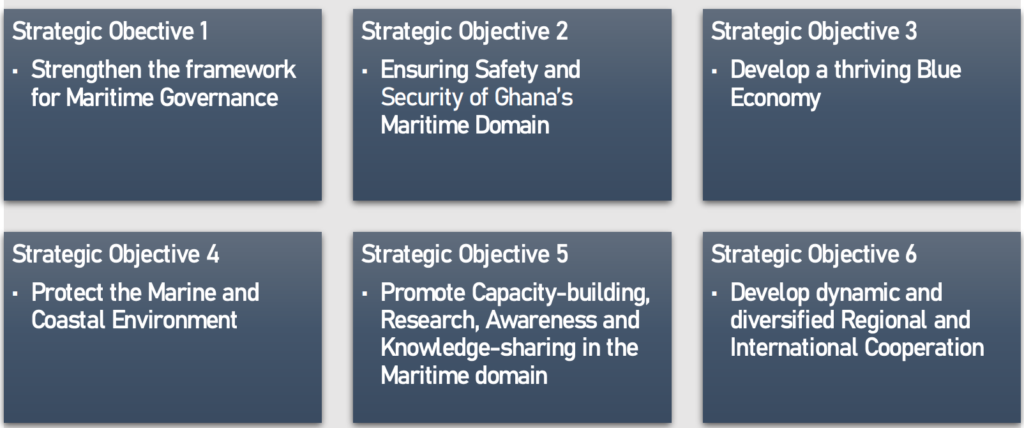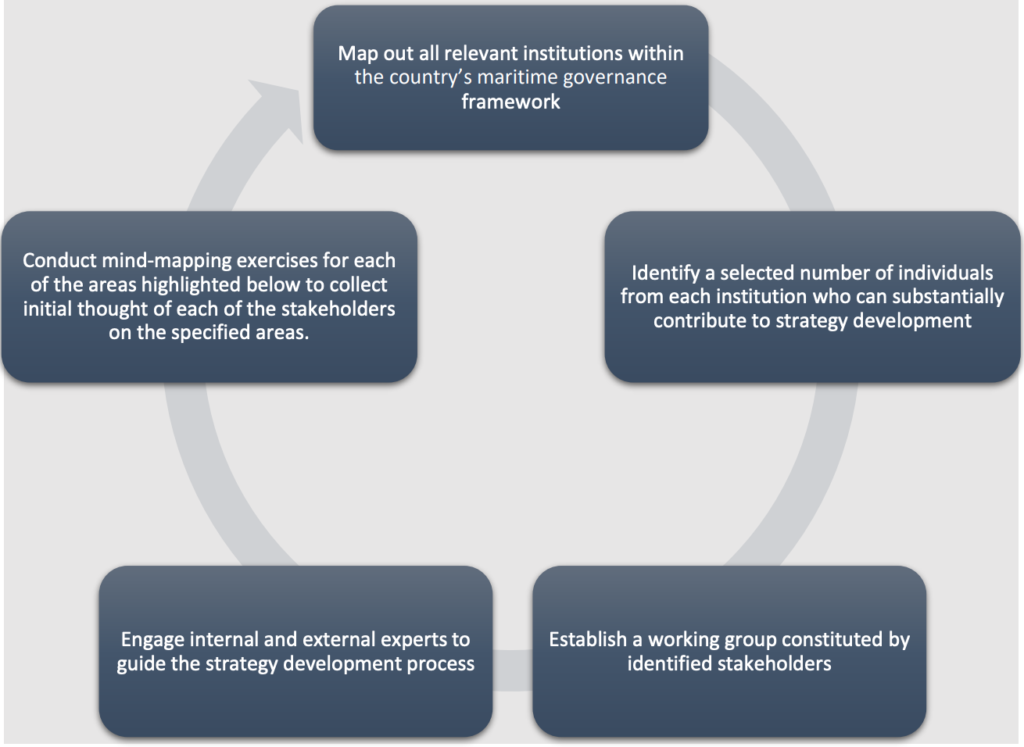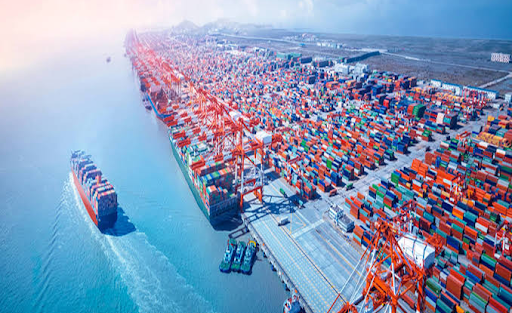Background
Ghana is a coastal state with vast maritime opportunities. The economy, livelihoods and culture of Ghanaians and the ocean are intricately linked. Efficient management of the oceans can greatly advance socio-economic growth and development in the country. With a 540km coastline, an extensive Exclusive Economic Zone (EEZ) and an extended continental shelf, the country encompasses a vast maritime space with huge potential to generate national revenue, sustain direct and indirect productive channels and provide employment to the nation’s burgeoning youth population. The extensive coastline and EEZ make up approximately 70% of its land mass. Approximately 25% of Ghanaians dwell directly in coastal communities. The maritime sector continues to record increasing contribution of both living and non-living resources to the national
economy. The fisheries sector, for example, generates over US$1 billion in revenue each year and accounts for at least 5% of Ghana’s Agricultural Gross Domestic Product (GDP) – a contribution that is likely to increase substantially with more effective and sustainable management of the maritime domain.
Equally important is the fact that in the last decade, Ghana’s maritime space has been one of the most active areas of oil and gas exploration in West Africa, and revenue from the industry has progressively contributed to the country’s socio-economic development. Interestingly, about 80% of the country’s hydrocarbon potential, most of which lies offshore, remains untapped. The country’s untapped hydrocarbon potential, fisheries resources and the strategic location of the coast along important international shipping lanes provide a sea of opportunities for ensuring food security, bridging income gaps, raising foreign investment, increasing national output and creating favourable terms of trade. However, the country’s maritime estate – if not properly managed – can also be a source of threats that undermine the effective execution of its maritime mandate. From the prevalent threat of piracy and armed robbery at sea across the sub-region to the mounting menace of Illegal,
Unregulated and Unreported fishing (IUU), over-fishing and plastic pollution, Ghana’s coastal space faces enormous challenges with serious repercussions.
Need for a Maritime Strategy
A maritime strategy anchored on effective ocean governance and investments in the blue economy will provide Ghanaians with a comprehensive and viable roadmap towards ensuring the safety and security of its maritime domain. Such a strategy will allow an integrated and coherent approach to addressing maritime threats, thus improving efficiency and effectiveness of efforts and actions amongst all relevant actors. The effective implementation of the strategy is expected to have the following positive impacts on socio-economic development (see figure below), while pointing out the indicators and core pillars on which the strategy rests. Noting also that the maritime space is a shared environment and integrates national and global interests, the national strategy is pivotal to ensuring synergy, coterminous uses and cooperative responses to challenges that undermine the collective use of this important global common.

The NIMS Development Process
The National Maritime Security Technical Working Group (NMSTWG) comprising of government officials from selected government agencies and ministries was established and granted the crucial role of developing the maritime strategy. The Centre for Maritime Law and Security Africa (CEMLAWS Africa) provided technical support and overall coordination under the US funded Security Governance Initiative (SGI). The Ghana Maritime Authority (GMA), which functions under the Ministry of Transport, is the main regulator of Ghana’s maritime industry. Thus, the representative of the GMA in the NMSTWG served as focal point for spearheading the NIMS development. The process was subsequently supported by two other Ghana-based NGOs: Gulf of Guinea Maritime Institute (GOGMI) and Centre for Security and Defence Studies (CSDS). This inter-agency process was crucial because the import of the strategy relied on aligning the interests and visions of the various sectors of the maritime domain.
The strategy development process commenced with a mind mapping stakeholder exercise, designed by CEMLAWS Africa, conducted in December 2018 to brainstorm the key elements of the NIMS. A template document was also developed and disseminated by the lead consultants, CEMLAWS Africa, to relevant actors with the aim of eliciting inputs from relevant public and private Ghanaian stakeholders to feed into the NIMS making it a living document; one that is made for people and owned by the people.

The development of the NIMS is guided by seven (7) core principles: national ownership, social inclusion and impact, synergy, accountability, partnerships and cooperation, technology and innovation and sustainability. Each of these principles is engrained in the provisions mapped out in the Strategy, making the NIMS a living strategy – one that takes into account current and future maritime threats and opportunities to advance Ghana through a sustainable and prosperous ocean economy, for the benefit of all Ghanaians.
The NIMS has also been developed with six Strategic Objectives in mind for the country:
- Strengthen the framework for maritime governance
- Ensure the safety and security of Ghana’s maritime domain
- Develop a thriving blue economy
- Protect Ghana’s marine and coastal environment
- Promote capacity-building, research, awareness and knowledge-sharing; and
- Develop dynamic and diversified regional and international cooperation
These Strategic Objectives are at the core of the NIMS and are backed by recommended Priority Actions – specific goals that must be met to ensure that the broad vision of the NIMS is attained. This Strategy, supported by its Implementation Plan, will be executed by a National Maritime Council, chaired by the Vice President of the Republic of Ghana. The Implementation Plan is key to the realisation of the vision and objectives of the NIMS. In practice, many policy documents globally, suffer an implementation deficit because of a lack of detailed plan providing for implementation. This has been appropriately taken care of in the Ghanaian NIMS context.


Overcoming Challenges
One of the major challenges encountered during the process has been the complex nature of Ghana’s maritime domain, particularly due to the increasing number of threats faced by the region. Although Ghana has made efforts in improving its maritime sector, the country still has a long way to go in terms of streamlining the sector in many areas. For example, in the case of fisheries, management laws and policies, overlaps with respect to ministerial role and mandate as against the role and mandate of the Fisheries Commission that has direct management and enforcement role over fisheries. This poses challenges in the clarity of leadership roles, and the NIMS resolved this by assigning leadership roles to both the Ministry and Commission. Other vexing issues are how to ensure improvement of the maritime tourism sector, maritime job creation, regional approaches to maritime governance, and the provision of resources and improvement of capacity of core law enforcement agencies, such as the Ghana Navy and Marine Police. All this would require major financial injection and investment.
Given the multi-stakeholder nature of maritime governance, one would expect challenges with regards to assigning different levels of roles on a subject matter. For example, who will be the lead and who will play a supporting role? In the development of the Implementation Plan document, stakeholders were assigned key and supporting roles in order to clearly identify which institutions would be responsible for each Priority Action/Implied Task during the implementation phase of the document. In this regard, there were challenges relating to the selection of the key institutions and their supporting counterparts. This is partly due to the aforementioned overlapping organizational roles. It takes time to come to a compromise on this issue, and where no compromise is reached, parity of roles can be corroborated by consultation, collaboration and synergy. Implementation of a NIMS framework requires a wide range of resources – tangible and intangible. Matching existing resources with required resources within the Implementation Plan document proved challenging and there is a tendency of either overstating or understating. Finally, there was debate as to how to effectively structure the NIMS institutional implementation framework/mechanism. Key areas of disconnect centered on whether the Strategy required the establishment of a new overarching body/institution to oversee its implementation, or whether existing institutional frameworks could be restructured to serve the purpose of the Strategy.
In concluding the discussion on challenges, two other issues are worth mentioning. While the NIMS document has been developed, there has been delays in its endorsement at the highest political level. Second, is the issue of funding to facilitate the seamless transition from the development of the Strategy (and its Implementation Plan) to actual implementation and execution.
Most of the issues directly encountered during the NIMS process were addressed collectively through stakeholder and dialogue sessions as well as through expert recommendations. While a number of these issues are yet to be resolved, considerable steps have been taken to tackle some of the challenges. This includes the adoption of the Harmonized Standard Operating Procedure in the context of law enforcement through a process supported by the UNODC. There are also ongoing processes to review Ghana’s fisheries and piracy legal frameworks. It is also refreshing to note that there has been reinforcement of regional cooperation powered by the Yaoundé Architecture and operationalized through the Multinational Maritime Coordination Centre zones.
Key Takeaways and Lessons – One Size Fits All?
Evidently, all countries have a unique maritime sector and different approaches and priorities for development of the sector. For this reason, a one-size-fits-all approach in developing a national maritime strategy may not be ideal. Nonetheless, one can identify a number of key steps that can serve as a guide in the strategy development process. Two key approaches may be identified: firstly, a mechanism for continuous stakeholder involvement in determining the content of the Strategy. Secondly, the adoption of a methodological approach by stakeholders to the development of the strategy content. Below is a depiction of general key steps that can be featured in a strategy.

Drawing on the lessons from the above experience, this policy paper suggests that a comprehensive and effective maritime strategy begins with an all-encompassing approach. A well laid-out plan with a strong national backing and funding will place any state on the right path in a maritime strategy development process. Effective maritime governance can only be successfully accomplished through a maritime strategy that not only concentrates on identifying core areas that require improvement, but also by adopting a strategy that carefully balances operations of land, sea and air to yield a harmonized and holistic maritime plan. Accordingly, there is the need to assess, reassess and evaluate at every step of the strategy development. To make a maritime strategy a success story, a number of key ingredients may be beneficial:
- The strategy development process must involve all key government agencies and other relevant stakeholders.
- Political will and backing that will accelerate the development, endorsement and implementation of the strategy.
- It must take into account the regional and global context of the strategy.
- Expert and technical support will help shepherd the process and sharpen the outcome – the NIMS.
- Collective institutional and national ownership is key, yet must be well balanced with drawing on independent experts to enhance objectivity.





